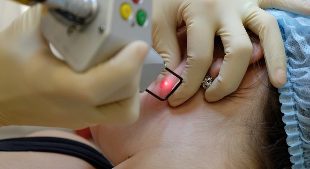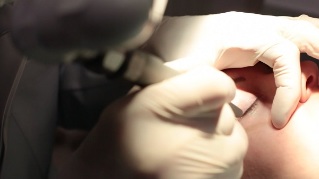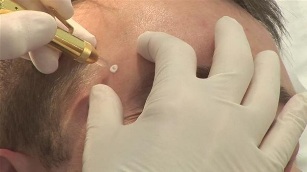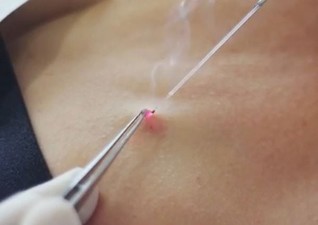
Removing neoplasm with a laser is a very common and effective procedure that helps relieve unwanted growth. It is a relatively new method, which appeared not long ago in the medical arsenal, But has already been successful in proving its advantage over other methods of removal. The precursors of laser destruction were removal using liquid nitrogen, electricity or a scalpel. All this can cause considerable discomfort to the patient, whileLaser removal shows good results of painless intervention.
why remove
Papillomas, which are growths of various shapes and sizes, are usually benign neoplasms. They are localized on the wearer or on the mucous membrane of its skin. The main reason for their appearance is the action of the human papillomavirus, in most cases sexual. Transmitted.
Removing these build-ups takes several tasks at once:
- aesthetic improvements.A development patient may be uncomfortable with excessive attention from others. Because of this, a person may feel insecure and uncomfortable, even if development is not a threat to him.
- injury prevention.If the growth is in a painful place where the patient touches it continuously, it can tear apart the spreading part. Also, when trying to cover the papilloma with clothes, rub the affected area. The problem is as it is. It is full of papilloma injury and possible subsequent infection. The injury can lead to the entry of microbes, which can cause inflammation in the wound. If this happens, the damaged area is treated with peroxide. Should go and immediately go to the clinic to remove the remaining part of the papilloma.
- reducing the risk of cancer.Despite the fact that the growth is benign in nature, there is such a diversity of their expression as condylomas. They are usually located in intimate spaces and pose a greater risk from the point of view of developing cancer. To prevent sickness, all warts should be removed.
Do not remove the build-up by yourself. Any attempt to tie papilloma with a thread, comb, applying some kind of chemical agent can worsen its condition.
benefits of the process
There are several advantages over other methods of removing laser destruction.These include:
- Guaranteed result.Thanks to the action of the laser, the exercise is completely removed, leaving nothing in even the deeper subcutaneous layers. The device cleans all traces of the presence of a neoplasm. Able to penetrate deep enough.
- painlessness.The patient gets minimal pain from exposure to the laser. If you add in the initial anesthesia procedure with local anesthetics, there is no pain at all.
- process speed. 2 to 5 minutes per element is required to remove papilloma with a laser.
- non-invasion.The laser beam is in a strictly confined area and does not go beyond. In this case, more than one part of the laser does not touch the site of the process. This is very important because this method reduces the risk of infectionAnd provide high guarantee of sterility.
- not a postoperative stain.If the work is done correctly, there should be no trace of laser action in place of the exposure. This is due to the fact that the affected tissue evaporates completely, and then the new, intact skin. It takes its place.
- bloodless method for removal.The laser beam heats the blood-supplying capillaries, quickly sealing their walls. Immediately, bleeding stops after surgery and does not resume.
- Suitable for different parts of the body.Not all removal methods can be used on every part of the body. Interiors, eyelashes, etc. are considered particularly sensitive. Laser destruction with build-up in such areas due to the accuracy of the laser beamWorks well.
All these factors make laser one of the most popular procedures to get rid of growth.
Paradox
The list of contraindications for this procedure is not prolonged for other methods of destruction.Between laser removal restrictions:
- diabetes mellitus;
- oncology;
- extension of chronic diseases;
- epilepsy;
- diseases associated with endocrine system problems;
- blood clotting;
- HIV or AIDS;
- acute inflammatory diseases.
Furthermore, patients who have recently had an influenza or acute respiratory infection should also postpone the procedure for some time.
process description
Before starting any procedure to remove the enlargement, the doctor will disinfect the area to operate. In some cases, local anesthetic is used. Usually, an ointment or spray is used for thisAfter applying the anesthetic, 2-3 minutes pass, and the removal process begins.

The laser beam is directed to the affected area and, as it were, prevents unwanted growth. At this time, the contents of the cells evaporate under the influence of the laser, removing each layer of the affected tissue. It occurs not only in easily accessible places but in open spaces. The process of removing papilloma, for example, on the eyelid, is similar. The only nuance in this area is that pain and irritation at this sensitive pointTo prevent, a special cooling method is used for the patient.
Neoplasm is removed in intimate locations according to the same principle. But here doctors usually use anesthetic injections as anesthetic, injecting growth from different sides.
The very moment the needle is inserted can be somewhat painful, but after a few minutes the sensitivity in the area of effect completely disappears, and further manipulations are completely painless.
The affected area turns into a small wound without blood. At the time of destruction, it disinfects due to laser work. After removing the build-up, the doctor treats the affected area with potassium permanganate. .
After the procedure, the patient may have mild redness, itching, or mild pain at the site of removal of the papilloma.
This reaction is considered normal, because, despite the non-invasiveness of the procedure, there was an interference with the integrity of the skin during the operation.All discomfort should completely disappear after 2-4 days of the procedure.
A dry crust appears above the wound. It already has a layer of healthy skin under it, so its protective shell cannot be torn until it collapses on its own. Otherwise, the skinBut a scar may remain, and the recovery process may take longer.
result
Complications after laser destruction are rare. As a rule, their presence is associated with diseases that the patient already has, which she did not cure before the procedure. Therefore, for example, If the patient's skin was inflamed, it may contribute to the appearance of pigmentation. If the skin itself is very sensitive, there may be a mild redness associated with the burn. With a high allergic reaction, edema may occur at the site of exposure. is.
To exclude all undesirable results, it is necessary to consult a doctor before excluding laser destruction.
care after the process
After removing the build-up, the patient must follow the following rules:
- Do not allow water to enter the wound for 2-3 days;
- Avoid visiting the sauna, bath and swimming pool;
- Do not rub the damaged area with a towel;
- Do not use adhesive plaster on the wound;
- Scrub at papilloma removal site, do not treat with lotion, which contains alcohol;
- Avoid exposure to ultraviolet rays.
Several times a day, antiseptic treatment of the wound is required to be done until the scab is removed. This treatment should prevent infection and help speed up the time of full healing.For the treatment of damaged area, you can take a solution of iodine or potassium permanganate.
The site can be treated with anti-inflammatory ointments after removal of.
Their action is aimed at accelerating tissue regeneration, relieving inflammation and edema. Before choosing a specific remedy, it is best to consult a doctor.
which method is better
Laser removal is not the only way to deal with unwanted growth. There are other methods, among which stand out:

cryodestoration.
Based on the removal of papilloma with liquid nitrogen. Due to exposure to low temperatures, erection begins and eventually disappears completely. The method is effective, but has many disadvantages. They have nitrogenThe impossibility of complete control over the depth of action of. The material can pass through very deep, touch a healthy area, or, conversely, only superficially, without affecting all layers of the localization of the construct. .
Also, this method is characterized by:
- possibility of postoperative scar;
- painful sensations;
- Inability to guarantee results after the first procedure.
Thus, laser destruction shows greater efficiency than cryodestruction. Removal with laser is less painful and is more likely to guarantee the desired result.
radio wave removal.
This method of destruction is carried out using a special device acting on papillomas via radio waves. This contributes to the fraction of build-up due to the point effect of the radio knife. Accuracy of process. Too high so that adjacent tissues are not affected. However, the risk of burns or infections is extremely low.
This method is suitable for the removal of small benign lesions. It is highly efficient, making it popular as laser destruction. Both methods are considered modern approaches to remove papilloma and are equally used in medicine. Used well.

electrocoagulation.
This method is based on the action of high-frequency electric current at the papilloma directly at the site of the wound. Electrocoagulation is now considered a common but outdated method. This method allows you to stop bleeding after removing the papilloma from burning vessels. Allows.
However, when using a high-frequency current, patients experience pain that manifests even after anesthesia. This causes some patients to abandon electrocautery, a more advanced and painless laser removal. Selects as method.
Estimated Cost
Theprice range depends not only on the area and clinic where the removal is performed, but also on the number, size and location of the removed developments.
Many clinics have a waiver to remove new growth in bulk: the more a patient has, the cheaper it is to remove a growth.
It can be quite expensive to get rid of growth in the genital area compared to other parts of the body. In addition, not every clinic offers such a service due to the complexity of such manipulation.














































































